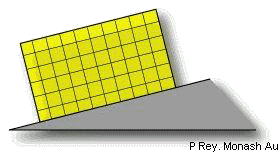TRANSLATION

Imagine the cross section of a cube or square referred to an imaginary cartesian coordinates x and y. When this square is bodily displaced in a single straight line or rectilinear direction without any shape change, this is called TRANSLATION. Many pre-Alpine nappes have actually moved over distances of more than 50 km in this manner. A commonly observed natural displacement is that of the two blocks either side of a fault plane with slickensided striae being straight and generally indicating the direction of movement of the two blocks or the MAXIMUM DISPLACEMENT VECTOR. The final position of the original point, say x,y is therefore now changed to x’,y’. The square may be rotated bodily and in this case the path of displacement of the original points is curved, or curvilinear and this is called BODY ROTATION. The rotational faults are a common example. A rotational path may actually be broken down to numerous small rectilinear paths, similar to an arc being broken down to a large number of straight line segments. In case of rotational paths, it will be hard to provewhether the rotation occurred alone or the result was a case of first translation in any given direction followed by a renewed rotational motion more or less an extension of the first.